Azaleas are grown primarily for their colorful flowers. Bloom colors include yellows and dark reds as well as pinks, purples, and whites. Blooms come in spring but also in midsummer and even fall depending on the variety.
Azaleas belong to the rhododendron genus. The rhododendron genus contains more than 900 species of deciduous and evergreen shrubs and trees. There are more than 10,000 named varieties. Rhododendrons range from tree-size with large leaves to prostrate with very, very small leaves. Azaleas range in size from low-growing, prostrate varieties to small and medium-sized shrubs.
Azaleas grow best in a cool, moist climate with plenty of moisture in the atmosphere. That said, evergreen azaleas can endure more heat than rhododendrons and grow well in mild-winter regions, with the exception of desert and mountain areas. Azaleas, like rhododendron, grow best in acid soil that stays evenly moist. Deciduous azaleas are the least demanding of an ideal soil.
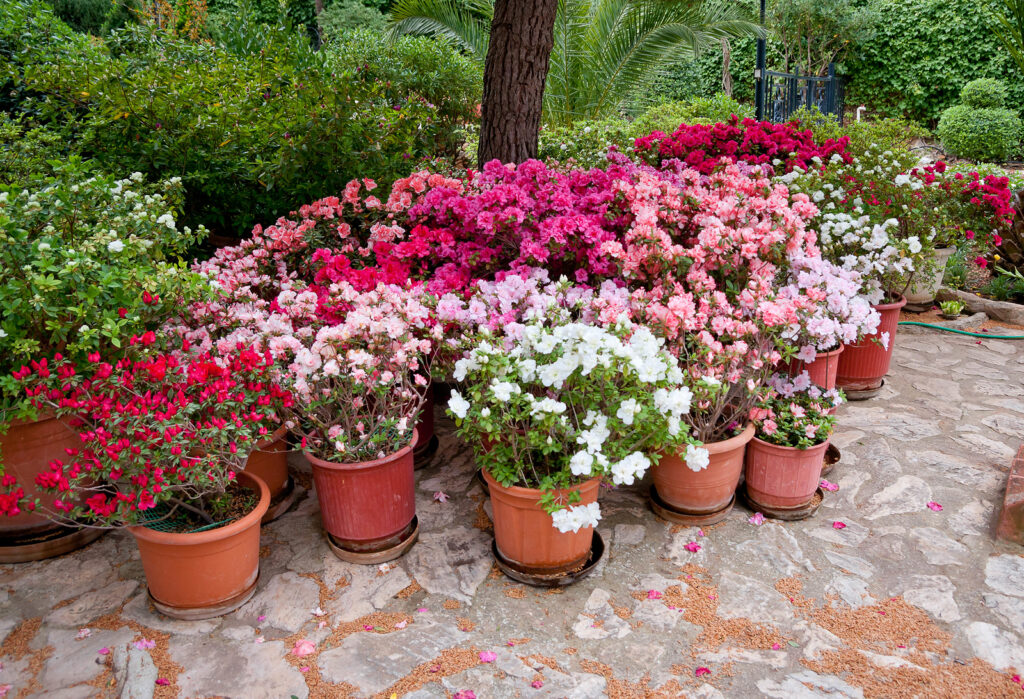
A number of hybrid azaleas have been developed; there are a variety of plant and flower sizes available and also hybrids with varied hardiness. As well, there are azaleas native to many parts of the United States and the world; if a hybrid variety does not grow in your garden, a good strategy is to replant with an azalea native to your region.
Botanically, azaleas are classified as rhododendrons. What’s the difference? Rhododendrons tend to be evergreen and have flowers shaped like bells, and azaleas tend to be deciduous and have funnel-shaped flowers. Azalea flowers have 5 stamens; rhododendron flowers have 10 or more stamens. That said, there are exceptions.
As a general rule, choose evergreen cultivars for milder regions as far north as Zone 9. These include Belgian, Southern Indian, Glen Dale, Pennington, Kehr, Glen Dale, Kurume, Back Acre, and North Tisbury (some of these are listed below). In cooler regions, Zones 5-6, grow Kaempferis, Robin Hill, Linwood, Girard, Gable, Shammarello, Schroeder, and Greenwood azaleas.
Where summers and winters are cool, grow deciduous azaleas. Deciduous cultivar groups include Ghent, Mollis, Knap Hill, and Exbury strains. In the western United States grow the native Western azalea (R. occidentale).
Rhododendrons are treated under a separate post at this website, but the growing requirements for azaleas and rhododendrons are essentially the same.
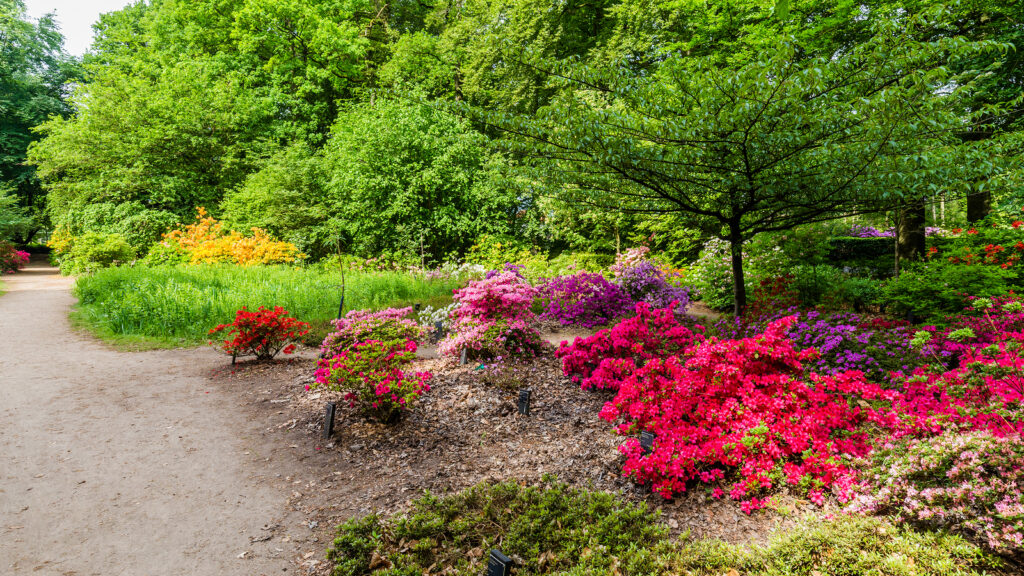
Get to know Azaleas
- Plant type: Evergreen or deciduous shrubs
- Growing zones and range: Zones 4 to 9 depending on the variety
- Hardiness: Cold hardy to -25°F (-32°C) depending on the variety
- Height and width: 1 to 4 feet tall and wide depending on the variety.
- Flowers: Commonly funnel-shaped flowers; colors in shades of pink, red, maroon, lavender, yellow, and white
- Bloom time: Spring, summer, or autumn depending on the variety.
- Uses: Borders, beds, edging, foundation, accent
- Companion plants: Plants that like the same conditions as azaleas but will not compete include primulas, lilies, meconopsis, gentians, trilliums, and erythroniums. Shrubs and smaller-leaved trees that are suitable include camellias, cornus, some maples, viburnums, and cotoneasters.
- Common name: Azalea
- Botanical name: Azalea
- Family name: Ericaceae

Where to plant Azalea
- Plant azaleas in dappled shade. Azaleas will grow in full sun where temperatures stay moderate in summer.
- Grow Azalea in humus-rich, well-drained soil.
- Azaleas grow best in loose, friable soil that the roots can easily penetrate.
- Add plenty of gritty sand and organic matter to clay soil before planting azaleas.
- Azaleas prefer acidic soil.
- Azaleas cannot tolerate hot, dry, or windy conditions.
- As a general guideline, the larger the leaf the more shade and shelter from the wind the azalea needs.
When to plant Azaleas
- Azaleas can be planted at any time, but spring and autumn are the times of the year when plants will be least stressed by transplanting. Autumn planting allows roots to become established before spring growth begins.
Planting and spacing Azalea
- Set azaleas in a shallow planting hole; azaleas have fine, surface-feeding roots so roots should not be set too deep.
- The rootball needs covering with no more than 1 to 2 inches (2.5cm) of soil. Planting too deeply can stunt plant growth.
- Space azaleas with mature height and width in mind. Allow some room between plants for air circulation which can decrease susceptibility to attack by pests and disease.
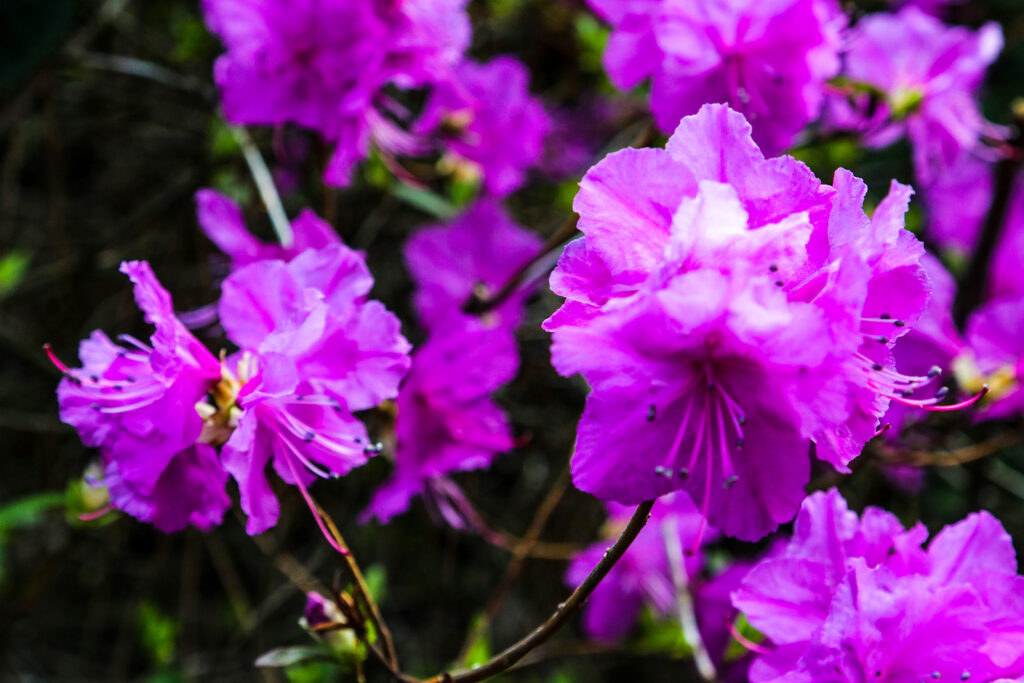
How to water and feed Azaleas
- Keep the soil evenly moist; avoid letting the soil dry out.
- Soak the soil well occasionally rather than watering a little and often.
- Feed azaleas with aged compost; many azaleas, particularly small varieties, are intolerant of fertilizers and easily suffer leaf scorch.
Azalea care
- Mulch around azaleas with pine needles or leaf mold; avoid cultivation which can disturb roots.
- Leaf mold and garden compost mulches provide nutrients that plants require; they are the best mulch choice.
- Keep the soil beneath and around azaleas free of weeds that compete for moisture and nutrients.
- Pruning azaleas is rarely necessary.
- Deadheading faded flower trusses bring on better new growth and more flower buds for the next season. When deadheading, be careful not to break off or damage the buds or young shoots just below the flowers.
- Pinch off spent flowers to avoid seed formation.
- Generally, the larger the leaf, the more protection the azalea needs from the wind.
- Young plants are especially vulnerable to frost and cold; cover them on cold nights with frost cloth.

Pruning Azaleas
- Most azaleas need no pruning. Old and straggly specimens benefit from being cut back.
- Prune late-flowering plants in late winter or just after flowering.
- Carry out severe pruning in two or three stages, leaving some foliage each time. Remove the thick branches first, and if these put out new growth, cut back or remove thinner branches as you prune to form.
Growing Azaleas in containers
- Grow azaleas in containers using acid, free-draining compost such as peat mixed with composted bark, good garden soil, leaf mold, or grit.
- Feed container-growing azaleas with a slow-release fertilizer.
- Wrap the pot to protect the roots in cold weather and shade plants in hot weather or move to dappled shade.
- Repot plants into slightly larger containers every second year and give liquid or slow-release food in the growing season.
- Remove part of the roots of large plants every 2 to 3 years and put them back in the same pot with fresh compost added.
- Yellow leaves may indicate iron chlorosis. Check to be sure that pH is acidic and treat the medium with chelated iron if necessary.
Growing Azalea as a houseplant
- Azaleas should be placed in a room where the temperature is cool, light is direct and humidity is high.
- The medium should be soilless, rich, slightly acidic, and well-drained.
- Forced plants which are commonly sold by florists and in grocery stores do not need fertilizing when they are in bloom.
- After the flowers have faded, remove them and prune the plants to shape them.
- The hardiness of forced azaleas varies considerably with the variety, but they may survive if planted outdoors where the minimum winter temperature is between 10° and 30°F (-12° and -1°C).
- To force your own azaleas into bloom, grow them outdoors in pots in partial shade over summer.
- Fertilize azaleas monthly.
- In fall, plants must have four to eight weeks of 35° to 50°F (1.7°-10°C) temperature to set flower buds, after which they should be moved indoors for forcing.
Azalea pests and diseases
- Rabbits and deer feed on azaleas and dwarf azaleas.
- Vine weevils, aphids, caterpillars, and slugs eat new leaves.
- Grey mold (botrytis) can afflict seedlings in autumn and winter.
- Powdery mildew can attack established plants.
- Honey fungus can attack and kill azaleas.
- Phytophthora, root rot, affects plants that have been kept too wet and too warm, especially plants growing in containers.
- Rust fungi can attack plants.
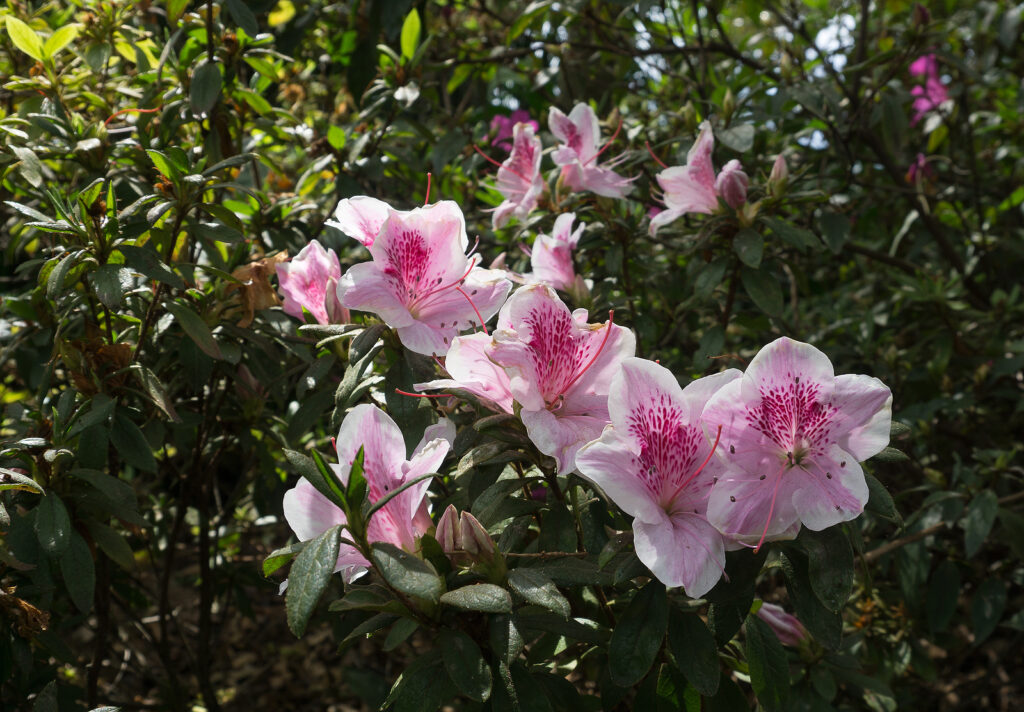
Azalea propagation
- Propagate azaleas by planting tiny seeds under a plastic cover and misting them daily.
- Sow seed when the ripe capsule turns brown and starts to split open. Sow seed in peat or sifted fresh sphagnum moss. Water from beneath.
- Sow seed outdoors in spring or sow seed indoors where heat and artificial light are available.
- Propagate azalea by layering. Help to layer by wounding the bark underneath. Keep the layer moist throughout the growing season. It takes a few years for an adequate root system to develop.
- Propagate azaleas by rooting semi-hardwood cuttings treated with hormone powder. Take cuttings from mid-summer onwards.
Azalea varieties to grow
There are two kinds of azaleas, evergreen azaleas, and deciduous azaleas. There are many cultivars and varieties between the two types.

Evergreen Azaleas
Here are some of the most popular groups of evergreen azaleas. Plant sizes vary within the groups.
- Belgian Indica Hybrids: This group was developed for greenhouse forcing but many are used as landscape plants; they have lush foliage and profuse large blossoms; lowest temperatures are 20° to 30°F (-7°—1°C). Varieties include ‘Mission Bells’.
- Brooks Hybrids: Bred for tolerance to hot, dry summers, compact growth, and large flowers; hardy to 20°F. Varieties include ‘Madonna’.
- Kaempferi Hybrids: Tall open growth; cold hardy to -15°F (-26°C).
- Kurume Hybrids: Compact, twiggy growth, dense foliage with small glossy leaves; small flowers in profusion; mounded habit; widely used as houseplants; varieties include ‘Coral Bells’, ‘Hino-crimson’, ‘Sherwood Red’, ‘Ward’s Ruby’.
- Rutherfordiana Hybrids: Greenhouse plant; can be used in a landscape where temperatures don’t go below 20°F (-7°C); bushy 2 to 4 feet; varieties include ‘Alaska’, ‘Constance’, ‘Dorothy Gish’, ‘Rose Queen’.
- Satsuki Hybrids: Low growing, some true dwarfs; can be used in hanging baskets; hardy to 5°F (-15°C); varieties include ‘Gumpo’, ‘Rosaeflora’, ‘Shinnyo-No-Tsuki’.
- Southern Indica Hybrids: Vigorous, fast growers; hardy to 20°F (-7°C); varieties include ‘Brilliant’, ‘Duc de Rohan’, ‘Fielder’s White’. ‘Formosa’, ‘Phoenicia’, ‘George Lindley Taber’, ‘Southern Charm’, ‘Pride of Dorking’.
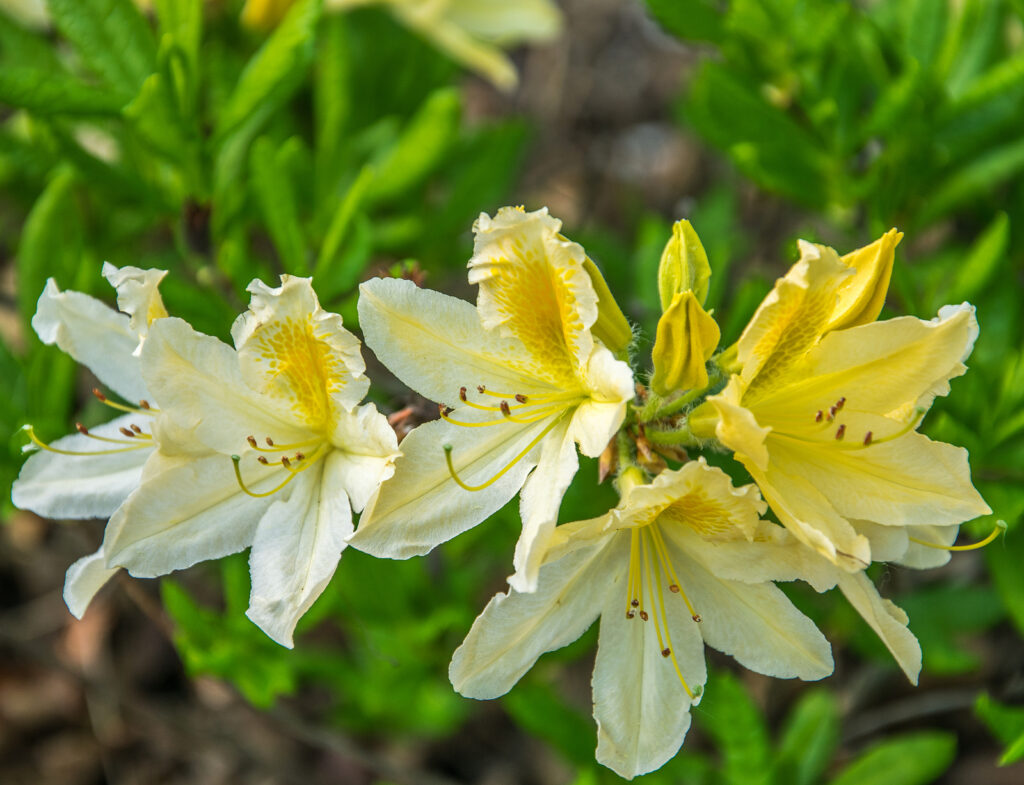
Deciduous Azaleas
Many deciduous azaleas are native to the eastern and southern United States and natives that grow along the West Coast. Deciduous azaleas are less particular about soil and watering than most evergreen types. Fall foliage is often brilliant orange-red to maroon. Here are some of the most popular groups of deciduous azaleas.
- Ghent Hybrids: Upright growth to a varied height; hardy to -25°F (-32°C); small flowers.
- Knap Hill-Exbury Hybrids: Plants vary from spreading to upright and grow from 4 to 6 feet tall; large flowers to 5 inches across in clusters of 7 or more, sometimes ruffled; hardy to -25°F (-32°C); varieties include ‘Cannon’s Double’, ‘Gibraltar’, ‘Homebush’, ‘Klondyke’.
- Mollis Hybrids: Upright growth to 4 to 5 feet tall; flowers to 4 inches wide in clusters; foliage turns yellow to orange in autumn.
- Northern Lights Hybrids: Grows 2 to 4 feet tall; hardy to -40°F; ball-shaped trusses of flowers.
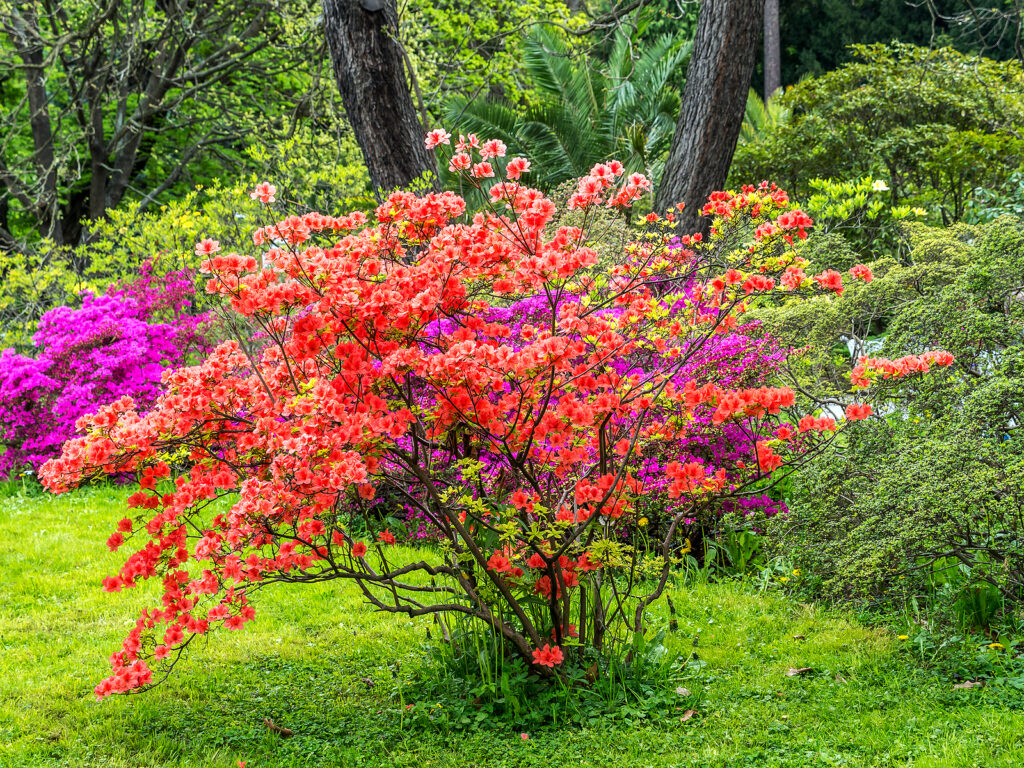
Deciduous Species Azaleas
- Rhododendron alabamense, Alabama azalea. Native to Alabama, George.
- R. aroborescens, sweet azalea. Native to mountains from Pennsylvania to Alabama.
- R. atlanticum, coast azalea. Native from Delaware to South Carolina.
- R. austrinum, Florida azalea. Native to northern and western Florida and southern parts of Georgia, Alabama, and Mississippi.
- R. bakeri, Cumberland azalea. Native to mountains of Kentucky, Virginia, Tennessee, George, and Alabama.
- R. calendulaceum, flame azalea. Native to mountain regions from southern Pennsylvania to Georgia.
- R. canadense. Native from eastern Canada to Pennsylvania.
- R. canescens, Piedmont azalea. Native from North Carolina to Texas.
- R. flammeum, Oconee azalea. Native to South Carolina, Georgia.
- R. japonicum, Japanese azalea.
- R. luteum, Pontiac azalea. Native to Eastern Europe, Asia Minor.
- R. oblongifolium, Texas azalea. Native to East Texas, Oklahoma, Arkansas.
- R. occidentale, western azalea. Native to the mountains and foothills of California and Oregon.
- R. periclymenoides. Native to Massachusetts, Ohio, and North Carolina.
- R. prunifolium, plum leaf azalea. Native to Georgia and Alabama.
- R. schlippenbachii, royal azalea. Native to Korea.
- R. vaseyi, pink shell azalea. Native to the mountains of North Carolina.
- R. viscosum, swamp azalea. Native to damp or wet ground Maine to Alabama.
Azaela frequently asked questions
Q: What is the proper soil for azaleas?
A: Acid, well-drained, and humusy. The addition of a liberal amount of oak leafmold or peat moss to the mixture is recommended.
Q: How do I take care of my indoor azalea after it blooms?
A: Keep the plant well-watered, in full light, in a room at 50°F. If the plant is overlarge for its pot repot to a pot one inch larger. Soak the soil after repotting. Use an acid potting mixture and press the soil in firm.
Q: Should I cut back my indoor azalea, and when?
A: Pinch back any extra long shoots, but don’t prune in the usual way you would other shrubs. Hard pruning can kill azaleas. Azaleas make short growth each year.
Q: How do I take care of azaleas growing indoors?
A: Pot azaleas should only be indoors during the winter and white in bloom. From mid-spring on, the pot can be sunk in the ground with light shade, and regular watering. Pinch back over-long growth. Use a general or liquid fish fertilizer occasionally. Bring the plant indoors before the first severe frost.
Q: How should I treat my tender azalea when I bring it indoors in autumn?
A: Keep the soil just moist, in a light, cool room at about 40°F until 4 weeks before you want full bloom, then bring it into a warm, sunny room, and water plentifully. Give the plant a complete fertilizer until color shows on the buds.
Q: Should an azalea have a rest period during the winter?
A: Yes. After you bring the plant indoors before the first hard frost, a potted azalea should be kept cool 40°F to 60°F and just moist until mid-winter. In late winter set the plant in a sunny but cool window, and fertilize as new growth develops.
Q: Why did my pot azalea lose all of its leaves?
A: Either the roots got dry or the foliage became infested with red spider mites. Both will cause defoliation. It is likely the plant cannot be revived.
Q: I got an azalea from the florist shop. It bloomed beautifully. Now it is dying. What can I do?
A: The room where your azalea is sitting is probably too hot and dry. Keep the plant in as cool a place as possible. Once a week submerge the pot up to the rim and let it stay until the soil feels moist. Miracid is a good fertilizer.















